China: Water safe after toxic spill
China has announced that water in polluted rivers in the northern city of Harbin is now safe for drinking.

Officials have declared water safe for drinking in Harbin city where supplies to 3.8 million people were shut down for five days after a pollution scare in a nearby river, but residents remained wary about taking their first sips.
“Harbin‘s water is now safe to use and drink,” Xiu Tinggong, vice director of the city’s health inspection bureau, said on local television. “Everybody can rest assured that the water is safe.”
But many residents decided not to drink it yet, just in case. “We still can’t be sure that it’s safe,” said bank worker Sun Ning as she loaded a shopping cart with bottled water for her household. “It’s not that we don’t trust the government, but we are still not totally at ease.”
Running water was turned back on in Harbin, the capital of north-eastern Heilongjiang province, on Sunday after supplies were shut down following a 13 November explosion at a nearby chemical plant that spewed toxins in the Songhua River.
Officials initially warned that the water was not immediately safe to drink after lying in underground pipes for five days.
At the Jinshan Restaurant, where cooks busily stuffed and wrapped meat and vegetable dumplings, bottled water and not tap water was being used for steaming.
Residents still wary
“It’s coming out, but we don’t dare use it,” said chef Jin Zhonghua. Jin said he lined up each morning before 9am to fill bottles from a water truck.
Food safety officials were quoted in official media as pledging to keep fish and other aquatic products from the Songhua River off the market.
Beverage makers using water from the Songhua would also face stepped up inspections for an indefinite period, the report said.
|
“Harbin‘s water is now safe to use and drink. Everybody can rest assured that the water is safe” |
Harbin‘s Education Bureau instructed schools to buy “quality water” for their students or have them bring their own bottled water from home when classes resume Wednesday after a week-long break prompted by the pollution scare, the official Xinhua News Agency reported.
The city has about 400,000 primary and secondary school students.
Indoor swimming pools and most of the city’s public bathhouses remained closed.
Even as water was deemed safe in Harbin, supplies to more communities along the river were cut off as the 80km long stretch of cancer-causing benzene moved its way downstream toward Russia. The authorities there were bracing for the spill to reach the border within days.
Beijing has offered no estimates on how many people rely on the Songhua for drinking water.
On Monday, 10,000 people downstream in Yilan County were without water service, China Central Television reported.
Tonnes of benzene
The 13 November explosion upstream in the city of Jilin killed five people and spewed about 100 tonnes of benzene into the river, authorities have said.
In Harbin, the ice-capped Songhua River showed no sign of the tons of benzene and related chemicals that had recently flowed through.
A kite-seller in Stalin Park named Wu De shrugged off the pollution scare, saying that it was a “small thing” that had not impacted his life at all.
“When the pollution passed, no one could tell,” he said. “There was no smell.”
 |
|
The Songhua river flows into |
But the spill created a political disaster for President Hu Jintao, who has promised greater government accountability in the face of endemic corruption and recurrent public health scares like bird flu.
The disaster also highlighted the costs of China‘s breakneck economic development, which has lifted millions out of poverty but left environmental protections in shambles.
Embarrassing apologies
Hu’s government issued embarrassing apologies to China‘s public and to Russia, where the nation’s emergency agency said Monday it was preparing to switch off running water and airlift activated carbon for use in water treatment facilities to help absorb the spill.
The Songhua River flows into the larger Heilong River, which is called the Amur in Russia.
Russia‘s Emergency Situations Ministry said the pollutants could affect 70 Russian cities and villages with a total of over 1 million residents along the Amur river, including Khabarovsk, a city of 580,000.
Officials said the benzene spill was expected to reach Khabarovsk on 10 to 12 December – or sooner.
China’s usually docile state-run newspapers have accused officials of lying about and trying to conceal the spill following the chemical plant blast, which killed five people and forced 10,000 more to flee their homes.
But on Monday, coverage on state-run television in Harbin was upbeat – with a variety show celebrating the return of water.
Young women in jade-green costumes danced with empty 40-litre water bottles on their shoulders. A comedian played with a giant squirt gun.